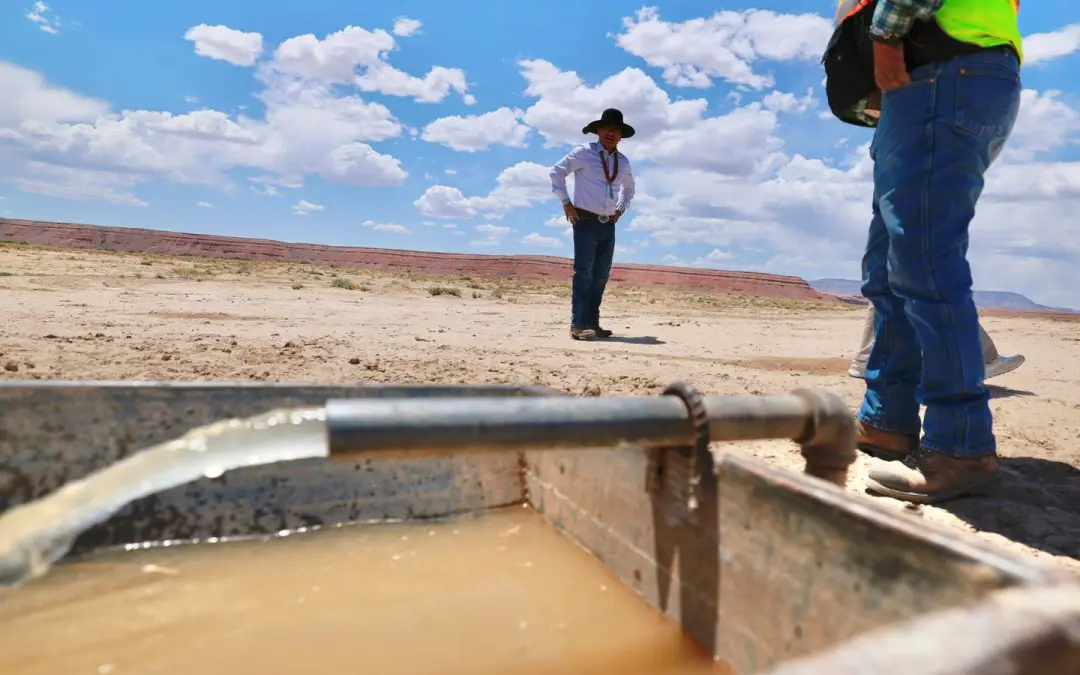
- Details
- By Native News Online Staff
The Navajo Nation Commission on Emergency Management (CEM) unanimously approved Resolution No. 25-005, officially declaring a State of Emergency in response to worsening drought conditions across the Nation. All six commissioners voted in favor of the resolution.
“This declaration reflects our commitment to protect our land, water, and livestock for future generations,” Navajo Nation President Buu Nygren said. “We must work together—across all levels of government—to ensure that no Navajo household is left behind during this drought.”
Resolution 25-005 addresses a range of urgent concerns, including critically low precipitation, deteriorating rangelands, declining water infrastructure, and heightened wildfire risks. The declaration calls on livestock owners to reduce herd sizes, instructs Grazing Officials to update tally counts, and encourages farmers to shift to drought-resistant crops. It also places restrictions on irrigation to conserve dwindling lake and reservoir supplies.
According to the resolution signed by both President Nygren and NCEM’s Chairman Marcarlo Roanhorse, the Southwest continues to be in a state of drought, with the U.S. Department of Agriculture deeming counties that make up the Navajo Nation as being disaster areas due to drought conditions:
-Apache, Navajo, and Coconino in Arizona
-McKinley, San Juan, and Cibola in New Mexico
-San Juan in Utah ,
“Our Nation is facing a dangerous convergence of water scarcity, degraded rangeland, and climate-driven threats,” said Commission Chair Marcarlo Roanhorse. “This declaration gives us the authority to respond with urgency, coordination, and resources. We cannot wait—our communities are already feeling the strain.”
The resolution authorizes $6,553,730 from the Agricultural Infrastructure Fund (AIF) to be directed toward critical repairs to windmills and the installation of water storage systems in drought-affected communities. It also supersedes all previous drought declarations, establishing this resolution as the official emergency declaration through September 31, 2025, unless extended by the Commission.
The resolution also references the May 22, 2025, drought emergency declared by New Mexico Governor Michelle Lujan Grisham, underscoring the importance of regional collaboration in the face of shared environmental challenges.
More Stories Like This
Native News Weekly (August 25, 2024): D.C. BriefsUS Presidents in Their Own Words Concerning American Indians
Two West Virginia Guardsmen Shot Near White House
Next on Native Bidaské: Chef Sean Sherman Talks “Turtle Island” and the Future of Indigenous Food
Deer Camp: A Family Tradition That Runs Deep
Help us tell the stories that could save Native languages and food traditions
At a critical moment for Indian Country, Native News Online is embarking on our most ambitious reporting project yet: "Cultivating Culture," a three-year investigation into two forces shaping Native community survival—food sovereignty and language revitalization.
The devastating impact of COVID-19 accelerated the loss of Native elders and with them, irreplaceable cultural knowledge. Yet across tribal communities, innovative leaders are fighting back, reclaiming traditional food systems and breathing new life into Native languages. These aren't just cultural preservation efforts—they're powerful pathways to community health, healing, and resilience.
Our dedicated reporting team will spend three years documenting these stories through on-the-ground reporting in 18 tribal communities, producing over 200 in-depth stories, 18 podcast episodes, and multimedia content that amplifies Indigenous voices. We'll show policymakers, funders, and allies how cultural restoration directly impacts physical and mental wellness while celebrating successful models of sovereignty and self-determination.
This isn't corporate media parachuting into Indian Country for a quick story. This is sustained, relationship-based journalism by Native reporters who understand these communities. It's "Warrior Journalism"—fearless reporting that serves the 5.5 million readers who depend on us for news that mainstream media often ignores.
We need your help right now. While we've secured partial funding, we're still $450,000 short of our three-year budget. Our immediate goal is $25,000 this month to keep this critical work moving forward—funding reporter salaries, travel to remote communities, photography, and the deep reporting these stories deserve.
Every dollar directly supports Indigenous journalists telling Indigenous stories. Whether it's $5 or $50, your contribution ensures these vital narratives of resilience, innovation, and hope don't disappear into silence.
 The stakes couldn't be higher. Native languages are being lost at an alarming rate. Food insecurity plagues many tribal communities. But solutions are emerging, and these stories need to be told.
The stakes couldn't be higher. Native languages are being lost at an alarming rate. Food insecurity plagues many tribal communities. But solutions are emerging, and these stories need to be told.
Support independent Native journalism. Fund the stories that matter.
Levi Rickert (Potawatomi), Editor & Publisher

